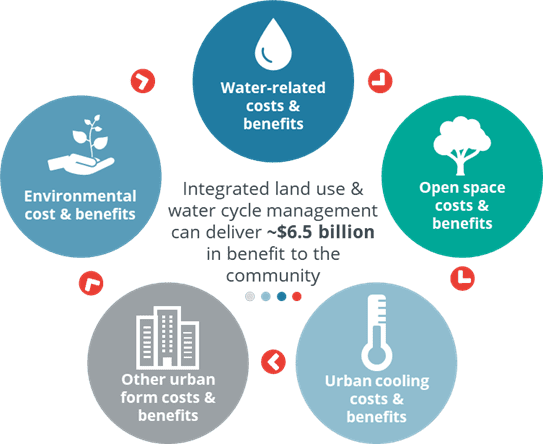Integrated planning, economics and quantifying the value of urban cooling
The costs of excessive urban heat are significant and lead to negative consequences for the health of our communities, environments and infrastructure. Increasingly, integrated planning of our natural and built environment covering blue, green and grey infrastructure is recognised as a force to reduce urban heat. This bulletin describes how mainstream evaluation practice can incorporate economic tools to identify, quantify and integrate urban cooling into decision-making frameworks in order to quantify benefits and support better decisions.
Excessive urban heat is a growing economic problem for our cities
Australia is particularly exposed to the physical risks of climate change, including heatwaves. In 2019 and 2020, Australia experienced the two hottest summers on record, with major metropolitan areas, as well as regional towns, experiencing catastrophic bushfires.
Across the coming decades, global temperatures are expected to rise more than 2.4⁰C above pre-industrial levels, the consequences of which are likely to disproportionally fall on our urban spaces.
Cities are more vulnerable to temperature rises because vegetation, open space and tree canopy is often replaced with concrete, roads and other heat-absorbing materials that radiate the heat they absorb during the day and through the night.
Our cities are already paying the price of excessive urban heat. These costs include increased pressure on our water and energy infrastructure as the infrastructure manages the consequences of increasing average and maximum urban temperatures. These also include increased likelihood of heat-related illness which put pressure on our healthcare sectors. Of all natural hazards, heatwaves currently represent the biggest cause of death in Australia.
However excessive urban heat can create longer-term costs associated with inactivity and mental health related illness as a result of reduced opportunities for passive and active outdoor recreation. Many of these costs accrue slowly over time.
At the same time, mainstream approaches to the provision of infrastructure and services are often blind to these costs, or struggle to rigorously recognise and incorporate them into decision making.
The good news is we have the tools to address urban heat: integrated planning of our natural and built environment covering blue, green, and grey infrastructure. This includes integrating the provision of:
- Tree canopy and open green space throughout the development (‘green infrastructure’)
- The use of water in the landscape such as water features, rivers and waterways (‘blue infrastructure’)
- The use of ‘cooler’ building materials such as green roofs, insulation, white paint for roofs and external shading including awnings, vertical fins and horizontal eaves (‘grey infrastructure’).
Blue, green and grey infrastructure provides the potential to use existing and any new infrastructure more efficiently and create cool, liveable communities and environments. In many respects, these investments can have public good related characteristics with benefits accruing to a range of beneficiaries, some beyond the local environment.
Blue, green and grey infrastructure provide proven urban cooling benefits, but are not always well integrated into decision-making
It is increasingly recognised that blue, green and grey infrastructure plays an integral role in the provision of cool, green, liveable cities. Despite this, historically the benefits of reduced urban heat have not been well integrated into infrastructure investment decisions.
In our experience, this is because the site-specific, dispersed nature of urban heat means for integrated blue, green and grey infrastructure investments (compared to more traditional investments), it can be more difficult to:
- identify the full range of benefits associated with a reduction of urban heat − which can involve economic, social and environmental changes − the magnitude of which vary significantly with the project and location, and so require robust place-based analysis
- measure and value the full range of benefits when they typically have no observable market price (i.e., non-market benefits such as reduced urban heat-related disease burden) requiring specialist economic valuation techniques, and
- engage with beneficiaries and securing co-funding. For example, beneficiaries can go beyond those who live and work in the area and include the broader community, governments, energy utilities and the health sector. The dispersed nature of beneficiaries means that it can often be difficult to secure co-funding from those who benefit from these investments.
- securing financing to cover what are often larger upfront investment costs for larger ongoing benefits (or cost savings). However, with growing investor appetite for green and sustainable investment opportunities, the potential for new and favourable funding opportunities have arisen for projects backed by a robust business case.
Economics is the key to integrating the value of urban cooling into decision-making
Too often these barriers have led to sub-optimal consideration of the benefits of reducing urban heat and risks inefficient allocation of scarce community resources and funding. This is especially pressing given that the current scale of urban development across Australia presents time-limited window of opportunity to avoid locking in our historical urban development paradigm for the long-run. Our decisions made today cannot be easily reversed.
The question then is, how do we embed active consideration of these urban cooling benefits into our decision-making process?

While government policy could mandate investment in blue and green infrastructure, prescribing a one-size-fits-all approach does not guarantee smart investments. In some circumstances, the expense of setting up and maintaining blue, green and grey infrastructure will be more than outweighed by its benefits.
Economic evaluation frameworks such as cost benefit analysis (CBA) provide the means to identify value-enhancing urban-cooling investments through incorporating and monetising these broader costs and benefits. This requires 3 steps:
- Identifying the causal link between the blue, green or grey investment and urban-cooling related outcomes (such as reduced energy demand, reduced heat related illness or increased inactivity related disease).
- Quantifying the incremental change (ΔQ), which can be challenging and often requires site-specific scientific or engineering analysis. For example, properly assessing the urban cooling mitigation impact of an urban heat mitigation option might require establishing the change in urban temperature attributable to water investments alone.
- Monetising this change in outcomes. (ΔQ x P), which can require undertaking primary research or the application of economic techniques such as benefit transfer.
While these steps are not always easy and can require collaboration across sectors and disciplines, they provide a robust and defensible framework for identifying where and when blue and green investments can cost-effectively manage urban heat.
We know this approach works: The $6.5 billion opportunity in Sydney’s Western Parkland City
The Western Parkland City is a priority growth area located in one of the hottest and driest parts of Greater Sydney. To draw people and businesses to the area, the City will need to offer a ‘cool and green’ environment. This means creating attractive urban communities and appealing places to live, work and play.
However, this urbanisation will place major pressure on the health of Wianamatta South Creek, its tributaries and the local environment and pose significant challenges in meeting a much higher community demand for water-related services. Water will also be needed to increase the urban tree canopy, maintain shaded, open and green space and support water features
Infrastructure NSW and Frontier Economics’ strategic options business case for the Western Parkland City (South Creek Catchment) found that, in the face of these challenges, integrated land use and water cycle management in the City can deliver significant economic, social and environment benefits.
The framework developed to monetise these economic, social and environmental impacts, found that integrated land use and water cycle management can deliver around $6.5 billion in benefits to the local, Greater Sydney and broader NSW communities.[1]
A key driver of these benefits was related to urban cooling related investments, which could lead to a reduction of up to 2.2°C in forecast maximum summer daily temperatures across the Western Parkland City. This reduction in urban temperature, in turn, was found to lead to associated reductions in energy consumption, peak demand, and heat-related deaths and healthcare costs.

Our analysis showed that quantifying these values in dollar figures enables effective policy, regulatory and investment decision-making, and ultimately leads to more attractive, liveable and productive places.
Further, as a result of our work with INSW, Infrastructure Australia designated blue-green infrastructure in the Western Parkland City as a national priority initiative.[1] It is a rare example of a non-traditional infrastructure project on the list.
Where to from here?
There is often only one chance to get urban spaces truly right, and now is the time to integrate the benefits of urban cooling into our urban infrastructure choices. It becomes harder and more costly to rectify the outcomes of poor past decisions.
Failure to address the resilience of cities to urban heat − including the role of blue, green and grey infrastructure − as a part of decision-making exposes the community to growing risks, which if were to crystalise would impose significant and broad economic, social and environmental costs.
Decision-makers should approach and incorporate economic, planning, design and development decisions.
Basing infrastructure decisions on good economics that draws on scientific, ecological, planning and engineering expertise and properly factors in economic, social and environmental outcomes into the ultimate investment decision is critical to delivering cool, green, liveable and resilient cities today and for decades to come.
This will require collaboration between economists, scientists, planners across the public and private sector to better identify, quantify, value and incorporate these benefits into decision-making.
[1] See NSW Government, Greater Sydney Water Strategy – Draft,2021, p80: https://www.industry.nsw.gov.au/__data/assets/pdf_file/0017/470501/draft-strategy.pdf
[2] https://www.infrastructureaustralia.gov.au/map/south-creek-integrated-land-use-and-water-cycle-management
DOWNLOAD FULL PUBLICATION




